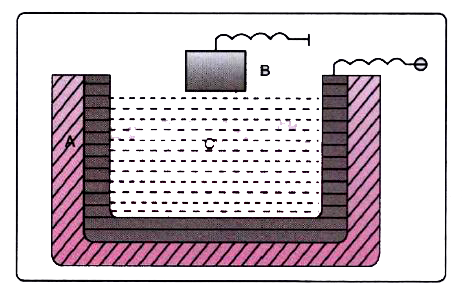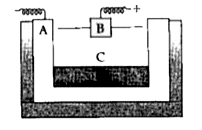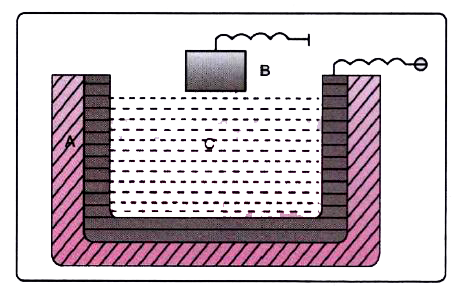How electrolysis can be used in extraction of aluminium? Why aluminium cannot be reduced by conventional reducing agents ?
Step-by-Step Solution:
Step 1: Understanding Electrolysis in Aluminium Extraction
Electrolysis is a process that uses electrical energy to drive a non-spontaneous chemical reaction. In the case of aluminium extraction, electrolysis is used to reduce aluminium oxide (Al₂O₃) into aluminium metal.
Step 2: Preparing the Electrolyte
Aluminium oxide is not directly electrolyzed because it has a very high melting point (about 2050°C). To facilitate the electrolysis, aluminium oxide is dissolved in a fused mixture of cryolite (Na₃AlF₆) and fluorspar (CaF₂). This mixture lowers the melting point of alumina and increases its electrical conductivity.
Step 3: Setting up the Electrolysis Cell
The electrolysis is conducted in an iron-lined tank. The lining of the tank serves as the cathode (negative electrode), while the anode (positive electrode) consists of carbon rods that dip into the fused electrolyte.
Step 4: Electrolytic Reactions
When the electric current is passed through the setup, the following reactions occur:
- At the Cathode: Aluminium ions (Al³⁺) gain electrons (3 electrons) and are reduced to form aluminium metal (Al).
Al3++3e−→Al
- At the Anode: Oxygen ions (O²⁻) lose electrons (2 electrons) and are oxidized to form oxygen gas (O₂). The oxygen atoms then combine to form O₂ molecules.
2O2−→O2+4e−
Step 5: Conclusion on Conventional Reducing Agents
Aluminium cannot be reduced by conventional reducing agents like coke, carbon monoxide, or hydrogen because aluminium oxide (Al₂O₃) is a very stable compound. The stability of certain metal oxides, including aluminium oxide, means that they require more energy to reduce than what conventional reducing agents can provide.
Electrolysis is a process that uses electrical energy to drive a non-spontaneous chemical reaction. In the case of aluminium extraction, electrolysis is used to reduce aluminium oxide (Al₂O₃) into aluminium metal.
Aluminium oxide is not directly electrolyzed because it has a very high melting point (about 2050°C). To facilitate the electrolysis, aluminium oxide is dissolved in a fused mixture of cryolite (Na₃AlF₆) and fluorspar (CaF₂). This mixture lowers the melting point of alumina and increases its electrical conductivity.
The electrolysis is conducted in an iron-lined tank. The lining of the tank serves as the cathode (negative electrode), while the anode (positive electrode) consists of carbon rods that dip into the fused electrolyte.
When the electric current is passed through the setup, the following reactions occur:
- At the Cathode: Aluminium ions (Al³⁺) gain electrons (3 electrons) and are reduced to form aluminium metal (Al).
Al3++3e−→Al
- At the Anode: Oxygen ions (O²⁻) lose electrons (2 electrons) and are oxidized to form oxygen gas (O₂). The oxygen atoms then combine to form O₂ molecules.
2O2−→O2+4e−
Aluminium cannot be reduced by conventional reducing agents like coke, carbon monoxide, or hydrogen because aluminium oxide (Al₂O₃) is a very stable compound. The stability of certain metal oxides, including aluminium oxide, means that they require more energy to reduce than what conventional reducing agents can provide.
Topper's Solved these Questions
- ELECTROLYSISBOOK - ICSECHAPTER - ELECTROLYSISEXERCISE - QUESTIONS FROM PREVIOUS ICSE BOARD PAPERS
96 Videos
- ELECTROLYSISBOOK - ICSECHAPTER - ELECTROLYSISEXERCISE - Additional questions
22 Videos
- ELECTROLYSISBOOK - ICSECHAPTER - ELECTROLYSISEXERCISE - WORK SHEET -4 (complete the following : )
5 Videos
- CHEMISTRY-2015BOOK - ICSECHAPTER - CHEMISTRY-2015EXERCISE - SECTION-II (40 Marks) Attempt any four questions from this Section.
49 Videos
- METALLURGYBOOK - ICSECHAPTER - METALLURGYEXERCISE - UNIT TEST PAPER 6 - Metallurgy (Select the correct answer from the list A,B,C & given in each statement.)
5 Videos
Similar Questions
Which of the following metallic oxides cannot be reduced by normal reducing agents?
View SolutionThe following is a sketch of an electrolytic cell used in the extraction of aluminium.

Why is it necessary for electrode B to be continuously replaced ?
View SolutionFollowing is the sketch of electrolytic cell used in the extraction of aluminium :
Name the ore used in extraction of aluminium .

View SolutionThe alongside figure is of an electrolytic cell used in the extraction of aluminium.
What are the two aluminium compounds in the electrolyte C?
View SolutionThe following is a sketch of an electrolytic cell used in the extraction of aluminium.

What are the two aluminium compounds in the electrolyte C?
View SolutionThe alongside figure is of an electrolytic cell used in the extraction of aluminium.
Why is it necessary for electrode B to be continuously replaced?
View SolutionGive appropriate scientific reasons for the following statements:
Zinc oxide can be reduced to zinc by using carbon monoxide, but aluminium oxide cannot be reduced by a reducing agent.
View SolutionGive appropriate scientific reason for the statement :
Zinc oxide can be reduced to zinc by using carbon monoxide, but aluminium oxide cannot be reduced by a reducing agent.
View SolutionIn the electrolytic extraction of aluminium, cryolite is used.
View SolutionWhich can act as a reducing agent ?
View Solution
